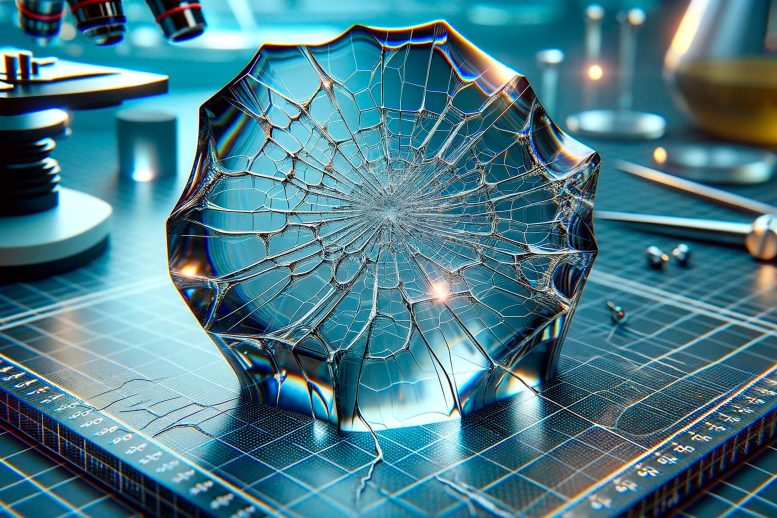
By using innovative imaging techniques, researchers have shown that crack complexity increases material toughness, challenging traditional views and suggesting new approaches in material design and testing. Credit: SciTechDaily.com
By capturing a rare glimpse into three-dimensional crack formation in brittle solids, EPFL researchers have found that complex cracks require more energy to advance than simple ones; a discovery that could improve materials testing and development.
The last time you dropped a favorite mug or sat on your glasses, you may have been too preoccupied to take much notice of the intricate pattern of cracks that appeared in the broken object. But capturing the formation of such patterns is the specialty of John Kolinski and his team at the Laboratory of Engineering Mechanics of Soft Interfaces (EMSI) in EPFL’s School of Engineering. They aim to understand how cracks propagate in brittle solids, which is essential for developing and testing safe and cost-effective composite materials for use in construction, sports, and aerospace engineering.

The scientists induced cracks in hydrogel samples with a standard Swiss Army knife. Credit: EMSI EPFL CC BY SA
Understanding 3D Crack Complexity
But traditional mechanics approaches to analyzing crack formation assume that cracks are planar – i.e., that they form on the two-dimensional surface of a material. In fact, simple planar cracks are just the tip of the iceberg: most cracks – like those in everyday brittle solids like glass – propagate into three-dimensional networks of ridges and other complex features.
Due to material opacity and the speed with which cracks form, observing this complexity in real time is extremely difficult. But now, armed with a Swiss Army knife and a confocal microscope, Kolinski and his team have managed to do just that – and they have discovered a positive correlation between crack complexity and material toughness in the process.
“The energy required to drive cracks has traditionally been considered a material property, but our work yields unique insights into the key role of geometry: namely, that by increasing the complexity of geometric features at the crack tip, a material can be made effectively tougher, because more strain energy is required to advance a complex crack than a simple one,” Kolinski says. “This highlights an important gap in the current theory for 3D cracks.”
The lab’s results have recently been published in Nature Physics.
A Fundamental Link Between Length and Strength
The researchers’ method involved creating very thin slices of four different hydrogels and an elastomer. Transparent and brittle, but easy to deform and measure without shattering, the hydrogels served as a proxy for understanding how cracks form in glass and brittle plastics. The elastomer was likewise a proxy for materials like rubber and silicone polymers.
While the experimental cracks were observed with a state-of-the-art confocal microscope, they were induced using a standard Swiss Army knife: the shearing action of the device’s scissors naturally produced geometrically complex cracks in the hydrogel samples. Using a custom apparatus developed by the EMSI team to control sample alignment and loading, a series of fluorescent images was generated with the confocal microscope, and then stacked to assemble a unique, three-dimensional map of each fracture surface.
“People have long known that cracks can become complex by looking at fracture surfaces after the fact, but what is lost is the understanding of the loading conditions when the crack emerged, or what forces the sample was exposed to,” Kolinski explains. “Our innovative imaging method has made it possible to characterize this relationship rigorously in-situ.”
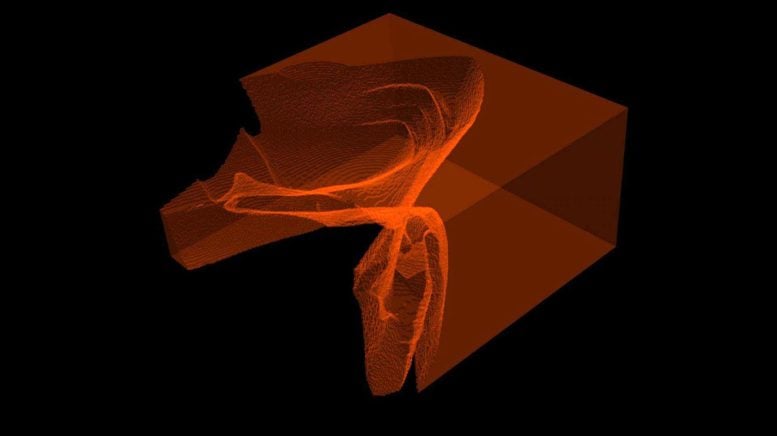
A rendering of 3D crack front data in a brittle hydrogel recorded with a confocal fluorescence microscope. Credit: EMSI EPFL CC BY SA
Experimental Insights and Implications
In a nutshell, these experiments revealed that the strain energy required to drive the sample cracks was directly proportional to the lengths of the crack tips. This suggests that the increased geometric complexity of a 3D crack generates more fracture surface as the crack advances, thus requiring additional strain energy to drive it.
In another experiment, the researchers showed how, as a smoother crack approached a rigid obstacle embedded in the sample, the crack’s planar symmetry was broken, increasing both the crack tip length and the energy required to drive the crack forward.
“The fact that we can isolate how geometric complexity emerges with such an inhomogeneity in the material could motivate new design approaches,” Kolinski says. “Our work also highlights the importance of care in carrying out materials testing, as we now know that any geometric deviation from a planar crack front may lead to a mis-measurement – and potentially dangerous over-estimation – of material toughness.”
Reference: “Complexity of crack front geometry enhances toughness of brittle solids” by Xinyue Wei, Chenzhuo Li, Cían McCarthy and John M. Kolinski, 22 March 2024, Nature Physics.
DOI: 10.1038/s41567-024-02435-x

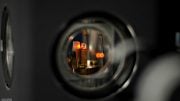
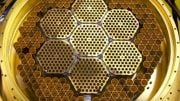
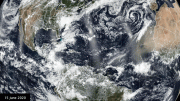

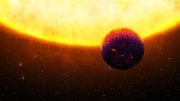
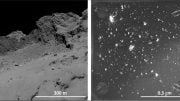

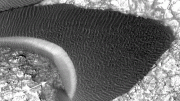
The increased geometric complexity of a 3D crack generates more fracture surface as the crack advances, thus requiring additional strain energy to drive it.
Very good! The universe does not do algebra, formula or fraction. The universe is geometrythe, and is the superposition, deflection, and twisting of geometric shapes.
According to topological vortex gravitational field theory, vortices (matter) and antivortices (antimatter) are formed simultaneously, with the same geometric shape but opposite directions of rotation. Countless topological vortices make spacetime motion more complex via the synchronous effects of superposition, deflection, and twisting.
The rotation of topological vortices is spin. Spin creates everything, spin creates the world, spin creates the future. In the interaction of topological vortices, time is both absolute and relative,and physics often requires treating space and time at the same level. Spin occupies space, spin generates time, spin generates gravitation, spin generates energy, spin generates evolution. Each topological vortex is a quantum clock. Starting from the formation of topological vortices, precise timing begins.
The interaction and balance of topological vortices not only demonstrate the beauty of mathematics, but also change the way humanity understand nature. Studying topological vortices can greatly expand the boundaries of humanity cognition.
All observable movements in the physical world are inseparable from the interaction of topological vortices, including human observational behavior itself.
Today, we have already entered the era of the internet. With the help of artificial intelligence and big data, discussions on scientific knowledge have become open and transparent. However, a group of editors of so-called academic journals (such as Physical Review Letters, Nature, Science, etc.) are self righteous, self proclaimed, fooling the public, lack remorse, and mystifying themselves. They only care about their own so-called sufficiently high priority rating, general significance, discipline, novelty, etc., and do not care about what science and pseudoscience are.
Science and pseudoscience are not determined by a publication, an organization or a person, nor by you or me, but by mathematics the final say. Physical models must be based on mathematics or mathematical models in order to be scientific, convincing, and in accordance with natural laws.
The origin of geometry lies in the concerns of everyday life. The branch of geometry (mathematics) known as topology has become a cornerstone of modern physics. Topological vortex and antivortex are two bidirectional coupled continuous chaotic systems. They exhibit parity conservation, charge conjugation, and time reversal symmetry. The synchronization effect is extremely important in their interactions. The synchronization effect of the superposition, deflection, and twisting of multiple or countless topological vortices will make spacetime motion more complex. To understand this complex world, physics should respect the authenticity of topological vortex in low dimensional spacetime, rather than simply relying on a few formulas, numbers, or imagined particles.
Spin is a natural property of topological vortices. Spin is synchronized with energy, spin is synchronized with gravitation, spin is synchronized with time, spin is synchronized with evolution. The perpetually swirling topological vortices defy traditional physics’ expectations. One physical properties of topological vortices is them to spontaneously begin to change periodically in time, even though the system does not experience corresponding periodic interference. Therefore, in the interaction of topological vortices, time is both absolute and relative,and physics often requires treating space and time at the same level.
Low-dimensional spacetime matter is the foundation of high-dimensional spacetime matter. Low-dimensional spacetime matter (such as topological vortex) can form new material structures and derive more complex physical properties via interactions and self-organization. It is extremely wrong and irresponsible to imagine low dimensional spacetime matter using high-dimensional spacetime matter,such as a cat in quantum mechanics.
Science must follow mathematical rules. For example, the Standard Model (SM) is considered to be one of the most significant achievements of physics in the 20th century. However, the magnetic moment of μ particle is larger than expected, revealed by a g-2 experiment at Fermilab, suggests that the established theory (such as SM) of fundamental particles is incomplete. Furthermore, the SM omitting gravitation, it not involved the time problem and when the particle movement starts. Mathematics is the foundation of science. Physics must respect the scientific nature of mathematics and mathematical models. The SM must be based on mathematical models in order to be scientific, convincing, and in line with natural laws.
I hope researchers are not fooled by the pseudoscientific theories of the Physical Review Letters (PRL), and hope more people dare to stand up and fight against rampant pseudoscience.
The so-called academic journals (such as Physical Review Letters, Nature, Science, etc.) firmly believe that two high-dimensional spacetime objects (such as two sets of cobalt-60) rotating in opposite directions can be transformed into two objects that mirror each other, is a typical case of pseudoscience rampant. If researchers are really interested in Science and Physics, you can browse https://zhuanlan.zhihu.com/p/643404671 and https://zhuanlan.zhihu.com/p/595280873.
The Physical Review Letters (PRL) is the most evil, ugly, and dirty publication in the history of science. Nature and Science have been influenced by Physical Review Letters (PRL) and are even more notorious. The behavior of these pseudo-academic publications has seriously hindered the progress and development of human society in science and technology.
I am well aware that my relentless repetition can make some people unhappy, but in the fight against rampant pseudoscience, that’s all I can do.
But traditional mechanics approaches to analyzing crack formation assume that cracks are planar – i.e., that they form on the two-dimensional surface of a material. In fact, simple planar cracks are just the semblance. Most cracks – like those in everyday brittle solids like glass – propagate into three-dimensional networks of ridges and other complex features. According to topological vortex gravitational field theory, in the interaction of topological vortices, even if there is only one electron or atom, it cannot be two-dimensional.
Traditional mechanics approaches to analyzing crack formation assume that cracks are planar – i.e., that they form on the two-dimensional surface of a material. In fact, simple planar cracks are just the semblance. Most cracks – like those in everyday brittle solids like glass – propagate into three-dimensional networks of ridges and other complex features.
According to the theory of topological vortex gravitational field, in the interaction of topological vortex gravitational field, observation is also a type of interaction. Anything observable, even just an electron or atom, cannot be two-dimensional. Each topological vortex is a quantum clock. Therefore, time and spin are inseparable.
Spin creates everything, spin creates the future. Studying the interactions of topological vortices can greatly expand the boundaries of human cognition.